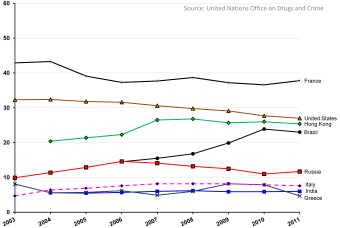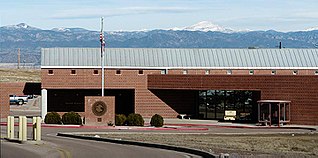| Rape |
|---|
| Types |
| Effects and motivations |
| By country |
| During conflicts |
|
| Laws |
| Related articles |
|
In France, rape is illegal, and marital rape is also illegal. In recent years there has been increase of reported rape cases in France.
| Rape |
|---|
| Types |
| Effects and motivations |
| By country |
| During conflicts |
|
| Laws |
| Related articles |
|
In France, rape is illegal, and marital rape is also illegal. In recent years there has been increase of reported rape cases in France.
Rape has been documented across French history. Georges Vigarello in his 2001 book writes about the history of rape in France, highlighting events from 16th to 20th century. He states that rape has historically been seen as a form of violence, but not punished as such. [1]

In 1971, the rate of declared rapes stood at 2.0 per 100,000 people. [2] In 1995, it was 12.5. [3] In 2009, it stood at 16.2. [4]
According to a 2012 report, about 75,000 rapes take place each year. [5] In 2012, there were 1,293 reported rapes in a population of 66 million, [6] and 1,188 rapes in 2013 in a population of 66 million. [7]
In 2015, rape rate for France was 20.1 cases per 100,000 population. Rape rate of France increased from 15.9 cases per 100,000 population in 2006 to 20.1 cases per 100,000 population in 2015 growing at an average annual rate of 2.72%. [8]
According to a 2014 report, about 5,000 to 7,000 of the rapes are gang rapes. [9] Gang-rapes are referred to as tournantes, or "pass-arounds". [10] [11] One of the first people to bring public attention to the culture of gang rape was Samira Bellil, who published a book called Dans l'enfer des tournantes ("In Gang Rape Hell"). [10] [11]
General:

San Quentin Rehabilitation Center (SQ), formerly known as San Quentin State Prison, is a California Department of Corrections and Rehabilitation state prison for men, located north of San Francisco in the unincorporated place of San Quentin in Marin County.
Ni Putes Ni Soumises is a French feminist movement, founded in 2002, which has secured the recognition of the French press and the National Assembly of France. It is generally dependent on public funding. It is also the name of a book written by Fadela Amara, one of the leaders of the movement, with the help of Le Monde journalist Sylvia Zappi.

Samira Bellil was a French feminist activist and a campaigner for the rights of girls and women.
In scholarly literature and criminology, gang rape, also called serial gang rape, party rape, group rape, or multiple perpetrator rape, is the rape of a single victim by two or more violators. Gang rapes are forged on shared identity, religion, ethnic group, or race. There are multiple motives for serial gang rapes, such as for sexual entitlement, asserting sexual prowess, war, punishment, and, in up to 30% of cases, for targeting racial minorities, religious minorities, or ethnic groups.

Femicide or feminicide is a term for the hate crime of systematically killing women, girls, or females in general because of their gender and/or sex. In 1976, the feminist author Diana E. H. Russell first defined the term as "the killing of females by males because they are female." Femicides are more often perpetrated by men against women. This is most likely due to unequal power between men and women as well as harmful gender roles, stereotypes, or social norms. Though femicide is not purely male-perpetrated but can be female-perpetrated as well.
Sohane Benziane was a French girl of Algerian ancestry who was killed at the age of 17.

Dans l'enfer des tournantes is a book by French activist Samira Bellil.

Greensville Correctional Center is a prison facility located in unincorporated Greensville County, Virginia, near Jarratt. The prison, on a 1,105-acre (447 ha) plot of land, is operated by the Virginia Department of Corrections. Greensville houses the execution chamber that was used to carry out capital punishment by the Commonwealth of Virginia until the death penalty in Virginia was abolished in 2021.

The Southern Ohio Correctional Facility is a maximum security prison located just outside Lucasville in Scioto County, Ohio. The prison was constructed in 1972. As of 2022, the warden is Donald Redwood.

The United States Penitentiary, Florence High is a high-security United States federal prison for male inmates in Colorado. It is operated by the Federal Bureau of Prisons, a division of the United States Department of Justice. USP Florence High is part of the Federal Correctional Complex, Florence, which is situated on 49 acres (20 ha) of land and houses different facilities with varying degrees of security. It is named "Florence High" in order to differentiate it from the United States Penitentiary, Florence ADMAX, the federal supermax prison located in the same complex.
Crime has been recorded in the United States since its founding and has fluctuated significantly over time, with a sharp rise after 1900 and reaching a broad bulging peak between the 1970s and early 1990s. After 1992, crime rates have generally trended downwards each year, with the exceptions of a slight increase in property crimes in 2001 and increases in violent crimes in 2005-2006, 2014-2016 and 2020-2021. While official federal crime data beginning in 2021 has a wide margin of error due to the incomplete adoption of the National Incident-Based Reporting System by government agencies, federal data for 2020-2021 and limited data from select U.S. cities collected by the nonpartisan Council on Criminal Justice showed significantly elevated rates of homicide and motor vehicle theft in 2020-2022. Although overall crime rates have fallen far below the peak of crime seen in the United States during the late 1980s and early 1990s, the homicide rate in the U.S. has remained high, relative to other "high income"/developed nations, with eight major U.S. cities ranked among the 50 cities with the highest homicide rate in the world in 2022. The aggregate cost of crime in the United States is significant, with an estimated value of $4.9 trillion reported in 2021. Data from the first half of 2023, from government and private sector sources show that the murder rate has dropped, as much as 12% in as many as 90 cities across the United States. The drop in homicide rates is not uniform across the country however, with some cities such as Memphis, TN, showing an uptick in murder rates.

The Union Correctional Institution, formerly referred to as Florida State Prison, Raiford Prison and State Prison Farm is a Florida Department of Corrections state prison located in unincorporated Union County, Florida, near Raiford.
Crime rates in Alabama overall have declined by 17% since 2005. Trends in crime within Alabama have largely been driven by a reduction in property crime by 25%. There has been a small increase in the number of violent crimes since 2005, which has seen an increase of 9% In 2020, there were 511 violent crime offenses per 100,000 population. Alabama was ranked 44th in violent crime out of a total 50 states in the United States.
According to the Louisiana Uniform Crime reporting program, there were 177,710 crimes reported in the U.S. state of Louisiana in 2018. 2018 had the least amount of non-violent criminal offenses since at least 2008. Violent crime decreased from 2017 to 2018, but 2012 still remains the lowest with its record of 22,868. Rape went up 12.7% from 2017 while murder/non-negligent manslaughter declined 7.8%. Additionally, robbery dropped 15% and aggravated assault dropped 1.5%. Handguns remain the leading murder weapon with a rate of 44.7% with firearm following close behind at 35.7%. Together, these two contribute for 80.4% of the murders. Similarly, robberies were committed mostly with firearms in 2018. Firearms were leading with 52% and strongarm listed with a percentage of 35%.

Crime in France is combated by a range of French law enforcement agencies.

Alfredo Rolando Prieto was a Salvadoran-American serial killer. After being initially convicted for a single murder, he would later be connected to eight other murders committed in Virginia and California between May 1988 and September 1990 via DNA profiling. Sentenced to death in both states, Prieto was executed by lethal injection in Virginia in 2015.